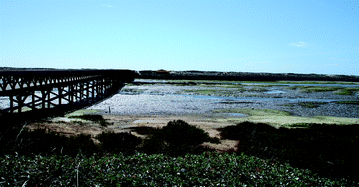Coastal shallow lagoons are considered to be highly important systems, which have specific biogeochemical cycles and characteristics. The assessment of sediment–water interfaces is essential to understand nutrient dynamics and to evaluate the vulnerability to eutrophication, especially in regions of restricted water exchange (RRE), such as the Ria Formosa, which have natural conditions for the accumulation of nutrients. Water samples were collected during the years of 2006 and 2007–08 for nutrients, chlorophyll a and dissolved oxygen. Sediment samples were also collected for pore water nutrients and microphytobenthic chlorophyll a. Measurements of temperature, salinity and photosynthetic active radiation were also taken. The lagoon salinity is affected by occasional strong rainfall events. From comparison with previous work, a decrease in the nitrogen concentration in the water column can be observed, which may indicate an improvement of the water quality. Pore water nutrient concentrations were significantly larger than in the water column. Sediment–water exchanges are considered to be the most important processes in nutrient dynamics of the lagoon. Benthic microalgal biomass was also large compared with that of the phytoplankton. It represents about 99% of the total microalgal chlorophyll biomass of the system. The lagoon also contains (discontinuous) meadows of intertidal seagrass, but we did not study these. Due to the importance of sediments, the standard monitoring plans required by the Water Framework Directive may fail to track changes in the nutrient conditions and the microalgal responses to them.

You have access to this article
 Please wait while we load your content...
Something went wrong. Try again?
Please wait while we load your content...
Something went wrong. Try again?


 Please wait while we load your content...
Please wait while we load your content...